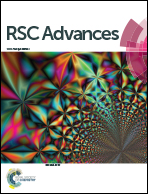Synthesis, biological evaluation and molecular docking studies of novel 1-(4,5-dihydro-1H-pyrazol-1-yl)ethanone-containing 1-methylindol derivatives as potential tubulin assembling inhibitors†
Abstract
A series of novel compounds (6a–6v) containing 1-methylindol and 1-(4,5-dihydro-1H-pyrazol-1-yl)ethanone skeletons were designed, synthesized and biologically evaluated as potential tubulin polymerization inhibitors and anticancer agents. Among them, compound 6q showed the most potent tubulin polymerization inhibitory activity (IC50 = 1.98 μM) and in vitro growth inhibitory activity against A549, MCF-7 and HepG2 cell lines, with IC50 values of 0.15 μM, 0.17 μM, and 0.25 μM respectively, comparable to the positive control. Furthermore, compound 6q was a potent inducer of apoptosis in A549 cells and it had typical cellular effects for microtubule interacting agents, causing arrest of the cell cycle in the G2/M phase. Confocal microscopy assay and molecular docking results further demonstrated that 6q could bind tightly to the colchicine site of tubulin and act as an anti-tubulin agent. These studies, along with 3D-QSAR modeling provided an important basis for further optimization of compound 6q as a potential anticancer agent.


 Please wait while we load your content...
Please wait while we load your content...